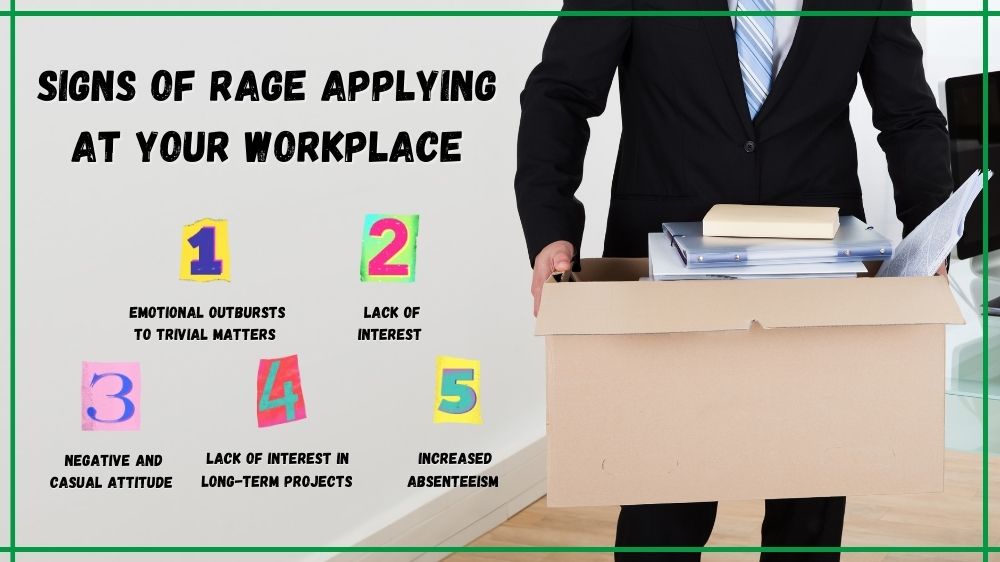Have you heard of “rage applying,” the newest office trend?
This new trend in the job market refers to job seekers who apply for any jobs out of frustration or desperation.
First came The Great Resignation in 2021, then Quite Quitting in 2022, and now Rage Applying in 2023. Seems, it is becoming harder for managers to retain talent during the pandemic times.
As a manager, you might have already encountered the difficulties that come with rage applying: instability in the organization, hampered project progress, current employees’ rage applying, lowered productivity and efficiency, and so on.
And on the hiring front, you may be dealing with sorting through mountains of irrelevant resumes, wasting valuable time and resources, and eventually delaying the recruiting process.
Knowing about phenomena beforehand will save you from suffering those unwanted headaches, and be ready to encounter the challenge when it comes!
In this article, we’ll look at the phenomenon of rage applying, its effect on the workplace, and some suggestions on how to deal with it as a manager, among other things. So grab your seatbelts, and let’s go!
If you want to learn directly about the solution to Rage Applying, you can navigate to Strategies to prevent rage applying at your organization.
What is rage applying?

Essentially, ‘rage applying’ means applying to multiple jobs at the same time – when you are dissatisfied with your current role and your current workplace. An employee is so fed up with the current job that he or she applies to any open positions in frustration.
Experts believe the roots of this trend come from rage quitting, where an employee abruptly leaves a job and begins a job search after quitting the current job.
But in rage applying, an employee is sending out resumes to multiple companies in rage while they are working on their current role; without even analyzing or sparing a second thought whether the companies they are applying to are a good fit for them.
Who is rage applying?
Rage applying is mostly popular with GenZ and Young Millennials because they are the generation that feeds on Instant Gratification. The moment they feel something is wrong such as a bad day at the office, some arguments with immediate supervisors, low salary, unclarity about the future, or not being able to ensure a certain lifestyle due to rising inflation, they indulge in rage applying.
Why do employees indulge in rage applying?
Various factors lead to rage applying. However, it all started when TikTok user Redweez, Canadian Millennial, shared in her video that she got a $25,000 hike when she ‘Rage-applied.’
That was the moment when this trend of “Rage Applying” erupted. Others joined and shared their experiences, and ‘Rage Applying’ became a new corporate resentment trend.
As this trend can impact you too, it is very important to understand why employees indulge in Rage Applying.
Three key reasons for rage applying
1. Dissatisfaction with current job

If you carefully examine the origin of Rage Applying, you will discover the Canadian Millennial shared, “I got mad at work, and I rage-applied to, like, 15 jobs.” Primarily, it is the dissatisfaction with the current job that leads to employee rage applying.
This dissatisfaction can be caused due to a toxic work environment, feeling disrespect, under-appreciation, no recognition, toxic bosses, lack of opportunities for advancement, and losing interest in the job due to lack of challenges (especially for the GenZ). This results in employees instantly applying for new jobs.
Check out: What to Do When You Hate Your Job!
2. Economic factors

The impact of the inevitable Global Recession in 2023 is already observed everywhere. Inflation in the economy leads to higher prices of goods and services, making it difficult for employees to match up their existing standards of living with their low-income salary.
To cope with the challenging economic times, employees are rage applying in pursuit of getting a salary hike. Many employees also revealed being unfairly treated by managers and ignored during promotion cycles and appraisals as one of the major reasons for rage applying.
COVID-19 has also contributed fairly to this trend because employees are not sure of their future. Especially GenZ who grew up in a time of COVID economy where they see their parents or someone losing their job or taking a pay cut. If managers do not communicate about plans, rather let them guessing like the older generations, GenZ and younger millennials are likely to go the route of rage applying.
3. Social influence

It is not all about reasoning. Some are just getting influenced by the trend. The fear of being laid off, the greed for a hike for a luxurious lifestyle, or just reasonable positive advice is fueling the trend. All of this collectively raged an employee to try rage applying.
Especially GenZ who spends over four hours a day on social media is highly influenced by this trend. When they see someone getting a fat pay cheque on social media, they immediately open the job portals and start rage looking and applying for new jobs.
How does rage applying impact your organization?

The trend, Rage Applying, has seeped into almost every industry due to its rising popularity. Even the top tech companies are not feeling convincingly immune to it. Thus, it is better to understand how it can impact your organization too.
Rage applying can negatively impact your organization primarily in two ways:
➞ You can lose the potentially qualified and skilled employees who are experienced and well-versed in your company’s workflow
➞ You may end up hiring a talent who is not a good fit for your organization
- When your existing employees indulge in Rage Applying: it leads to instability in the organization, may create a negative workplace environment, and make it difficult for HR professionals to fill the empty space with the right talent.
It results in hampered project progress, inconsistent project quality, lowered productivity and efficiency, gradual fall of the work environment, and damage to employer brand image as dissatisfied employees often give negative feedback.
- When you are hiring talent which is Rage Applying: it results in a lengthy screening process of applications, a costly hiring process, a higher rate of turnover, and lower retention rates. It is because rage applying is not always the right approach. Employees are sending applications in rage without researching the company and analyzing their own needs.
They are likely to be focused on escaping from where they are rather than really thinking about where they are going.
Industry experts are even posing rage applying as a new Quiet Quitting.
6 Strategies to prevent rage applying at your organization
According to Achievers Workforce Institute (AWI) survey, which includes over 5,000 employees and HR leaders worldwide, you need to focus on three primary things:
- Make sure employees are heard
- Make sure employees are seen
- Make sure employees are appreciated
As a project manager, you are very well aware of the dynamics of your organization. Still, it is a good idea to make your organization immune to Rage Applying by following these five practical strategies to prevent rage applying, and don’t let this 2023 trend be a headache, at least, in your organization:
1. Take feedback – Conduct an internal survey

The best way to ensure where you stand as an employer is to take feedback from employees. You can conduct an internal survey to receive good feedback and ensure you listen to your employees and their ideas. The quality of the survey plays an important role in giving you actionable insights.
Make sure survey questions are to the point and serve the goal of the survey. For example, if you are conducting a survey on employee satisfaction, you can include the questions like:
- Do you feel valued for your contributions?
- Do you find your work meaningful?
- Do you feel connected to your coworkers?
- Do your managers value your feedback?
- Are we open to change as an organization?
For actionable insight, make sure you conduct a multiple choice questions survey as it is easy to compile and analyze. And, there should be a provision at the end for detailed feedback, suggestions, or free commentary.
Doing this will ensure your employees feel heard!
Pro tip: Create an anonymous survey to generate genuine employee feedback.
2. Create a positive work and learning environment

In AWI survey findings (shared above), it was revealed that meaningful actions taken on employees’ feedback result in 37 percent less likely job hunting in 2023.
You got it right there. You need to take action on the pain points discovered from the employee survey.
For example, if 65% of employees say that they do not feel valued for their contribution, enhance reward and recognition.
If 37% of employees say they are not appreciated, speak a few words of genuine appreciation; for every department.
And when you say it, make sure you mean it. Because your employees will know the difference. And when you mean it, it often results in your employees sticking around longer.
Doing this will ensure your employees feel seen and appreciated!
Suggestion: If there is a need to re-evaluate your work culture, invest a fair share of thought and efforts into it, adopt policies backed by data insights and expert opinions, and fill the gaps which cause employees to rage.
If a significant part of your workforce is GenZ, know GenZ values challenges and new opportunities at its workplace. You can make it part of your work culture to keep them engaged and make them feel they are growing.
3. Set the expectations right
Clearly define what is expected of each role and designation. This will help employees understand their responsibilities and help hold them accountable. Setting unrealistic expectations results in anger, frustration, and low self-confidence as it is hard for employees to fulfill them.
You need to clearly get into the head of employees. They are here to work and you have to set realistic expectations for them. You can also consider employees’ POV too on the expectations and what they think about them. This will help you avoid conflicts and anger in the long run.
Pro tip: Document expectations of each role and designation.
4. Provide work-life balance

Richard Branson, founder of the Virgin Group, once famously said, “Take care of your employees, and they’ll take care of your business”. It is as simple as that. If your employees feel valued, are happy, and see their future with the organization, they will refrain from rage-applying.
You can do simple things like encouraging employees to take small breaks after every 1.5 or 2 hours, providing them with time off when needed, organizing some workplace fun activities, and also encouraging them to engage in activities outside of work they love. This will send the message to the employees you think of employees as more than just mere work.
You can also invest in training programs where employees can build the skills of the future and improve their personality. This will ensure your employees will think more than twice before leaving the organization, let alone the rage.
5. Develop open communication

You may think of all the right things you are doing in your organization. But without employees opening up about the reality, it is hard to say you make yourself immune to corporate resentment. Develop open channels of communication and encourage employees to speak of the issues they are facing at the workplace so that you can address them. This helps you prevent rage-applying at your workplace by addressing issues when they just arise.
A poll revealed that 72% of Generation Z prefer in-person communication in the workplace. Make sure you get in touch with them via face-to-face communication and address their concerns.
6. Avoid the pitfalls of bad hires

Sometimes you have to deal with employees who have joined your organization through rage applying. They are often not a good fit for your organization as they create instability in your organization. They can damage brand reputation by writing negative reviews on public platforms and impact employee retention and turnover.
The latest survey from software development company Lattice found, “52% of new hires already were searching for another job after three months or less with an employer.”
It happened because they have not given enough thought to their new job.
To address that, you need to pay attention to reviewing and evaluating low-quality applications. Increase time and efforts in screening applications, have a layered interview process where an employee is judged on various parameters, and refer to the previous companies to know more about the employee.
Want to know more about how to improve your hiring process? Check out our blog: Hiring The Right Talent: All Aspects Covered.
While going through this blog post, there would be times when you realized that your organization might be suffering from rage applying. Let’s look at the signs that help you identify rage applying at your workplace.
Signs of rage applying at your workplace

It is hard to predict whether your employees are rage-applying, but these five signs can help you identify it because these are similar to signs of an employee who has decided to leave the organization.
1. Emotional outbursts to trivial matters
If even the minor issues start making a great deal, it is a sign an employee may be rage-applying. It is accompanied by emotional outbursts. Such employees won’t care much about being on good terms with immediate supervisors or peers in the workplace as they decide to leave the company.
2. Lack of interest
If you see someone quite quitting, it is a sign that an employee may indulge in rage applying sooner as anger is building up. This can be easily identified by a lack of interest in work, not fulfilling responsibilities, and a lack of active participation.
3. Negative and casual attitude
A sudden shift of attitude and an employee becoming vocal in a negative manner, criticizing every little thing, is a sign that your employee may be rage-applying. You can also look for another sign which is a step before the negative attitude, i.e., a casual attitude. If someone is losing interest in doing work that they were doing very well or withdrawing from workplace activities, it is a sign of a casual attitude.
4. Lack of interest in long-term projects
If an employee is not willing to collaborate on long-term projects or putting the required effort, it is a sign they are not planning to stay too long. Such employees will not even accept new roles and responsibilities. Thus, you can identify the rage-applying behaviors.
5. Increased absenteeism
This is a sure-shot sign there is nothing much of significance left for an employee in the current organization. Such employees may not inform about the leaves, delay replies to emails, and suddenly seem uninterested in even being present at the workplace.
Addressing rage applying at your workplace
If there is a problem, there are solutions too. You can address the rage by applying the following these measures:
- Confront the issue: Hiding the problem under the carpet is not going to solve the issue. Ask the employee who is showing signs of rage applying to open up about the issues they are facing and try to address them. Provide them with genuine support, help, and assurances they need, and see how they respond to it. Make them clear how you expect them to go further.
- Take actions if required: If the employee’s behavior has started affecting others and he/she is not willing to work together, it is time to take disciplinary action. Because you cannot allow your raged employee to infect others. This will have an overall negative impact on the morale of your employees and the work environment of your organization. And, start finding the right talent though you originally did not want it to go that way!
The lessons learned
Rage applying has become a trend for the year 2023. It is a challenge we all managers are facing, but taking prompt and corrective actions can make our organization immune to it. If not completely immune, at least minimized it.
The learnings are not only for managers. It is for employees too who are indulging in rage applying. We have learned it need not be a good thing always. They may end up putting themselves in the same place from which they are seeking respite — and we have seen both industry experts and statistics confirming that. It also becomes their responsibility not to indulge in these unstable corporate practices.
The correct approach would be to sit, talk and find a solution — both for managers and employees!
If you want to understand more about how to make the workplace more employee-friendly and ways to avert these corporate trends such as Quite Quitting, The Great Resignation, and Rage Applying, you can read our blogs:




















No Comments